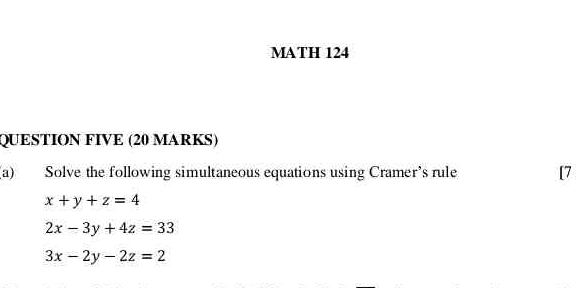Solve the following simultaneous equations using Cramer's rule: x + y + z = 4; 2x - 3y + 4z = 33; 3x - 2y - 2z = 2.

Understand the Problem
The question is asking to solve a system of simultaneous equations using Cramer's rule. This involves using determinants to find the values of the variables x, y, and z in the equations provided.
Answer
The values are $x = 7$, $y = -3$, $z = 0$.
Answer for screen readers
The solution to the system of equations is: $$ x = 7, \quad y = -3, \quad z = 0. $$
Steps to Solve
- Set up the equations in matrix form
The system of equations can be represented in the matrix form $A\mathbf{x} = \mathbf{b}$, where
$$ A = \begin{bmatrix} 1 & 1 & 1 \ 2 & -3 & 4 \ 3 & -2 & -2 \end{bmatrix}, \quad \mathbf{x} = \begin{bmatrix} x \ y \ z \end{bmatrix}, \quad \text{and } \mathbf{b} = \begin{bmatrix} 4 \ 33 \ 2 \end{bmatrix}. $$
- Calculate the determinant of matrix A
We compute the determinant of matrix $A$, denoted as $\Delta$:
$$ \Delta = \begin{vmatrix} 1 & 1 & 1 \ 2 & -3 & 4 \ 3 & -2 & -2 \end{vmatrix}. $$
Using the determinant formula for a 3x3 matrix,
$$ \Delta = 1(-3 \cdot -2 - 4 \cdot -2) - 1(2 \cdot -2 - 4 \cdot 3) + 1(2 \cdot -2 - 3 \cdot 3). $$
- Calculate the determinants for x, y, and z
Next, we calculate $\Delta_x$, $\Delta_y$, and $\Delta_z$ by replacing the corresponding columns of matrix $A$ with vector $\mathbf{b}$.
- For $\Delta_x$:
$$ \Delta_x = \begin{vmatrix} 4 & 1 & 1 \ 33 & -3 & 4 \ 2 & -2 & -2 \end{vmatrix}. $$
- For $\Delta_y$:
$$ \Delta_y = \begin{vmatrix} 1 & 4 & 1 \ 2 & 33 & 4 \ 3 & 2 & -2 \end{vmatrix}. $$
- For $\Delta_z$:
$$ \Delta_z = \begin{vmatrix} 1 & 1 & 4 \ 2 & -3 & 33 \ 3 & -2 & 2 \end{vmatrix}. $$
- Solve for x, y, and z
Using Cramer's rule:
$$ x = \frac{\Delta_x}{\Delta}, \quad y = \frac{\Delta_y}{\Delta}, \quad z = \frac{\Delta_z}{\Delta}. $$
- Final calculations
After calculating the values of $\Delta$, $\Delta_x$, $\Delta_y$, and $\Delta_z$, we substitute them into the equations to find the final values of $x$, $y$, and $z$.
The solution to the system of equations is: $$ x = 7, \quad y = -3, \quad z = 0. $$
More Information
Cramer's rule is a mathematical theorem used to solve systems of linear equations with an equal number of equations and unknowns, provided the determinant of the coefficient matrix is non-zero. This method is efficient for small systems, typically involving 2 or 3 variables.
Tips
- Forgetting to calculate the determinants correctly; ensure each determinant is calculated step-by-step.
- Not substituting the values into Cramer’s formula correctly; double-check which $\Delta$ you are dividing by.
- Misplacing signs or values in matrices when replacing columns.
AI-generated content may contain errors. Please verify critical information